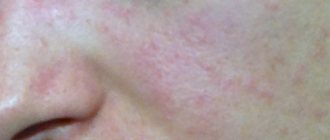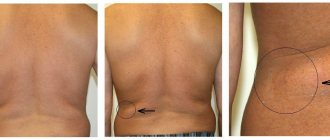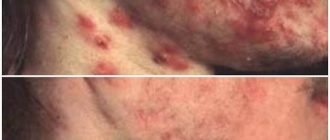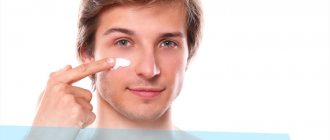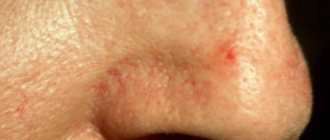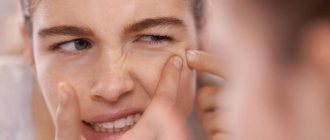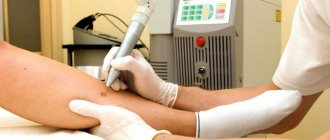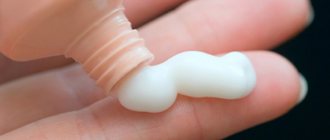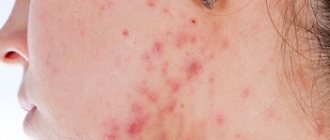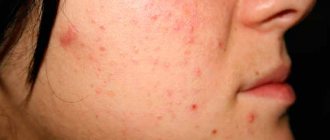Telangiectasia (rosacea) is a fairly common and very unpleasant facial skin problem. When redness appears on the face caused by pathological dilatation of blood vessels, this is rosacea.
Couperosis on the face appears in the form of thin vascular veins, stars or meshes. They can vary in size and location on the face. Couperosis is most often observed on the nose and cheeks. This cosmetic problem is associated with a certain aesthetic discomfort, so its solution is an important task.
What is rosacea
Healthy vessel walls, if necessary, can expand if blood supply needs to be increased, or, conversely, narrow. With rosacea, the capillary walls weaken, causing the muscle fibers to become paralyzed. The vessels close to the epidermis fill with blood and remain motionless, so the vascular network becomes visible on the face and redness is noticeable, especially in the cheeks and nose.
Cuperosis should not be masked; it is necessary, first of all, to pay attention to the reasons that caused the pathology
How rosacea develops on the face:
- At the initial stage of development (erythrosis), short-term redness of the face occurs in the area of the nose, cheeks, and chin. Excessive dryness of the skin in these areas may simultaneously occur. At first, this phenomenon occurs for no apparent reason and can persist for a rather short time or persist for several days. At the site of epidermal damage, a feeling of itching and tingling may occur; the skin becomes especially sensitive and prone to irritation. At this stage, small blood vessels still retain their elasticity, so the vascular pattern on the face is not yet noticeable.
- At this stage, spider veins begin to appear on the face, which indicates that the capillaries have already lost their ability to contract and cannot return to their normal state. Redness becomes persistent in certain areas of the face, vascular nodules are noticeable under the skin, and a capillary network with red-violet veins clearly stands out against the background of healthy skin.
- At the last stage of the disease, chronic disorders of blood microcirculation occur, which leads to frequent inflammatory phenomena and insufficient nutrition of the skin. Because of this, the skin begins to age and fade prematurely, the complexion deteriorates significantly, the skin acquires a pale grayish tint, and the vascular network appears more and more clearly on it.
Important! Most often, manifestations of rosacea are visible when exposed to external factors - drinking alcohol, exposure to cold or hot air.
To eliminate rosacea on the nose and face, you need not to engage in “masking” unpleasant manifestations, but first of all pay attention to the reasons that caused the pathology.
Classification
Like other diseases, rosacea on the face has its own classification.
Below is a photo of rosacea with different stages (1st, 2nd and 3rd with rosacea), which clearly shows the progression of the disease:
The disease is divided into stages; there are 3 of them:
- 1st stage. It is characterized by local manifestations of redness on the cheeks, chin and sides of the nose. In some cases, the skin in these areas begins to peel off. This stage has a name - erythrosis. Redness of this type may appear after exposure to provoking factors or for no apparent reason. In areas with redness, sensitivity is increased, there may be a sensation of itching or tingling, and hot flashes are also possible. As a rule, the redness goes away; this can happen either after a few minutes or after a few hours;
Why does rosacea appear?
It is difficult to independently identify the cause of rosacea, especially if it concerns internal diseases. Therefore, it is better to undergo a medical examination to identify the causes of the pathology, and seek help from specialists (hepatologist, phlebologist, endocrinologist, dermatologist, neurologist).
To identify the cause of rosacea, it is better to undergo a medical examination
Causes of rosacea:
- Sensitive skin type, in which there is excessive dryness and thinness of the epidermis. It should be taken into account that rosacea can also occur in oily skin types - in this case, there is a single dilation of blood vessels near the nose.
- Genetic predisposition. If relatives have suffered from rosacea, the person develops an innate tendency to this pathology.
- Excessive and prolonged exposure to ultraviolet rays - exposure to direct sunlight, frequent visits to the solarium. In this case, the skin not only ages quickly, but also the condition of blood vessels is disrupted, which leads to rosacea.
- Sudden temperature changes. Temperature fluctuations force the vessels to adapt to one or another conditions, which ultimately leads to their depletion. The vessels can no longer adapt to temperature changes, which can lead to rosacea even in thick skin.
- Bad habits. Smoking and alcohol abuse disrupts the functioning of the cardiovascular system, which affects the condition of the small capillaries of the face.
- Liver pathologies, endocrine disorders and pressure surges – these diseases place additional stress on the vessels, which provokes the occurrence of rosacea.
- Stress. Emotional changes provoke pressure surges, due to which the normal functioning of blood vessels is disrupted, and the capillaries cannot withstand the load.
- Improperly balanced diet: carbonated drinks, spicy and fatty foods, coffee, tea in large quantities, lack of vegetables and fruits affect blood circulation and can provoke rosacea.
If doctors discover an internal disease, then therapy for the underlying pathology will be prescribed together with treatment for rosacea. If no obvious health problems are identified, then the patient is advised to reconsider his lifestyle, improve his diet, give up bad habits, provide appropriate skin care and at the same time begin to eliminate the manifestations of the disease.
Remedies for rosacea
In the initial stages of the disease, a good effect can be achieved by using medicinal cosmetics, a wide range of which is available in pharmacies. A dermatologist will help you choose the optimal drug for rosacea on the face at the pharmacy, who will prescribe a course of treatment and make recommendations for the use of certain products.
Treatment of rosacea should be comprehensive and include the use of creams, ointments and gels for external use, taking vitamin complexes and special medications internally, and performing hardware procedures to remove the capillary network. The doctor will tell you whether a different drug can be used in the treatment of rosacea, based on the patient’s skin type, its condition and the stage of development of the disease.
Medications help only in the early stages of rosacea development
Medications against rosacea:
- Troxevasin is a drug with a natural composition (rutin + ascorbic acid) to strengthen blood vessels. External and internal use of the drug reduces the permeability of the walls of blood vessels, prevents their fragility and increases elasticity. More often, Troxevasin for rosacea is used externally; tablets are prescribed for extensive lesions. Course of treatment - ointment for rosacea is rubbed twice a day until the stars disappear completely.
- Diroseal is a cream for rosacea on the face, relieves skin inflammation, activates metabolism in cells, hides the vascular network, and compacts the upper layer of the epidermis. Long-term use of the cream will allow you to get rid of rosacea for good.
- Ascorutin is a multivitamin complex containing rutin and vitamin C. It helps reduce the manifestations of rosacea and eliminate the fragility of blood vessels. Ascorutin tablets also often serve as the basis for the preparation of various masks, tonics and creams for rosacea.
Note! In the complex treatment of rosacea, injections of vasoconstrictor drugs can be used.
Medications help only in the early stages of rosacea development; in severe cases, more serious measures will be needed to treat the pathology.
Treatment with cosmetic procedures
Special modern methods of struggle have been developed against rosacea, which are carried out in beauty salons.
Modern methods of combating rosacea have been developed and applied in beauty salons.
How to get rid of rosacea on the face:
- Laser treatment. Painless and highly effective removal of rosacea, allowing you to eliminate spider veins of any complexity. The essence of the method is exposure to laser radiation, with the help of which small vessels are heated and soldered, as a result of which the capillary networks disappear. Laser treatment is safe, has a quick recovery period, and has no complications.
- Electrocoagulation. Dilated vessels are destroyed using an electrical impulse that is delivered through a thin needle. The disadvantage of this method is that after treating too large areas, scars may remain on the skin.
- Photorejuvenation. Exposure to high-intensity light pulses on areas of the skin affected by rosacea. As a result, small vessels disappear, and other areas of the face do not experience stress.
- Mesotherapy. Point injection under the skin of microinjections with a specific medicinal composition into the problem area. The administered injections retain their effect for a fairly long period, so the procedure does not need to be repeated often.
- Ozone therapy. The lumen of the damaged vessel is filled with an oxygen-ozone mixture using a special needle. Thanks to this, the cells are saturated with oxygen and changes in the capillary walls are eliminated. This method is safe and effective; after it is completed, there are no scars or age spots left on the face.
In some cases, rosacea may require several cosmetic procedures, after which the cosmetologist will make recommendations for skin care using certain cosmetics, taking medications based on vitamins C, K, and routine.
To consolidate the results of treatment, special skin care at home will be necessary.
Note! Sometimes, with rosacea, it is suggested to carry out ultrasonic facial cleansing, but this procedure will be relevant only at the initial stage of the disease. In advanced cases, this method will not only not help, but, on the contrary, will be dangerous for damaged skin.
After cosmetic procedures and drug treatment, it will be necessary to consolidate the results obtained, which will require special skin care at home.
Cuperosis on the legs - laser treatment
But, unfortunately, what helped my face did not remove rosacea on my thighs. I consulted a specialist three times; as it turned out, I had the initial stage of rosacea on my face, so masks and ordinary products from the pharmacy helped effectively, but I would have to suffer with my legs. The doctor warned that even after treatment, the results will need to be constantly supported by proper care at home.
Removal of rosacea with a laser is considered virtually painless; anesthesia is not used and the patient is not specially prepared. But if the affected area is large, then treatment is carried out with an anesthetic in the form of a cream or solution. After the session, you can immediately return to everyday life. The cost of one session is from 900 to 5,000 rubles. This indicator depends on the clinic, doctor and degree of the disease.
Such operations are not performed on pregnant women, nursing mothers and patients with cancer. Before surgery, you should not drink alcohol, take antibiotics, or sunbathe.
As a rule, neodymium laser and diode laser are used to remove rosacea.
The neodymium laser copes well with deformed vessels due to the uniform distribution of the beam over the entire affected area. Moreover, this professional device is equipped with a cooling system that prevents the skin from overheating and thus does not cause burns.
The diode laser is used for blue vessels, since it does not cope so well with red vessels. And for some patients, 1 session is enough to completely get rid of rosacea.
Treatment at home
Treatment of rosacea at home with folk remedies requires a careful approach. You should not carry out procedures that can increase blood circulation and cause vasodilation. For facial care for rosacea, soothing masks, lotions and compresses based on herbal natural ingredients are used.
For facial care with rosacea, products based on herbal natural ingredients are used.
How to treat rosacea with folk remedies:
- Herbal compresses based on chamomile, St. John's wort, calendula, yarrow, horsetail. Decoctions should be gentle, at room temperature.
- Ginger mask. Ground ginger (5 g) is poured into 100 ml of boiling water, then cooled and the problem areas are moistened with the broth using a cotton swab.
- Apple cider vinegar lotions. Vinegar is mixed with water (1:4) and applied 2 times a day to the vascular mesh.
- Green clay mask. One tablespoon of clay is diluted with water to the consistency of thick sour cream. The mixture is rubbed into problem areas of the kodi for 10 minutes, after which it is washed off with warm water.
- Potato mask. Peeled potatoes are grated on a fine grater, and the resulting gruel is applied to the face for 10 minutes. Remove any remaining mask with lotion or chamomile decoction.
- Masks for rosacea made from fresh berries. Mix crushed sea buckthorn, lingonberries, raspberries, and strawberries in equal proportions with potato starch. The mask is applied for 20 minutes, after which it is washed off with warm water.
Daily skin care for rosacea should include cleansing with natural oils (almond, peach, almond). When washing, you should use decoctions of herbs with an anti-inflammatory effect (chamomile, chamomile, sage, calendula). Cosmetics should be based on natural extracts (green tea, ginkgo biloba, olive, horse chestnut).
Important! When using folk remedies against rosacea, you should ensure that they do not contain aggressive substances - salt, onions, mustard, citrus fruits, spices, etc.
Lymphatic drainage massage helps well with rosacea, which lowers blood pressure in the vessels, promotes blood outflow and relieves redness. Lymphatic and Japanese massage for facial rosacea is not recommended
Nutrition during the treatment of rosacea should be enriched with vitamins to strengthen the walls of blood vessels: vitamin P (parsley, carrots, asparagus, buckwheat), fish oil, green tea, protein, flaxseed oil. During the period of therapy, semi-finished products, black coffee and tea, fatty meats and fish should be excluded from the diet.
Skin care recommendations
People suffering from rosacea or prone to it need to use cosmetics for sensitive skin. The composition of cleansing, nutrition and moisturizing products must include active substances that can prevent the appearance of vascular network.
The cosmetic line must be selected in such a way that creams, tonics and lotions are gentle and have a gentle effect.
Cosmetologists have developed basic recommendations for caring for skin prone to rosacea:
- To cleanse the skin, use soft water or micellar water.
- Contrast washing - alternating warm and cool water - has a great effect on skin tone and capillary elasticity.
- Soap should be replaced with foam or gel for washing without alcohol or fragrance.
- Tonic or facial milk should have an anti-inflammatory and soothing effect.
- The use of washcloths, brushes and hard towels should be avoided.
- Therapeutic products are applied to clean and dry skin.
- Avoid overheating of the face by avoiding saunas, solariums and summer sun rays.
- You should avoid scrubs and skin cleansers containing granules or other particles.
- In winter, the skin requires intensive hydration and additional protection before going outside.
- Grapeseed, jojoba or olive oils will help maintain optimal skin moisture levels.
After studying the information and photos, it is important to react in time to vascular changes in the face, start using cosmetics suitable for skin with rosacea and, if necessary, urgently begin more serious treatment.
Article design: Oleg Lozinsky
What not to do with rosacea
It is difficult to get rid of rosacea at home, but it is quite possible if you treat with folk remedies along with medications and follow certain recommendations:
- Do not wash your face with cold water or wipe your face with pieces of ice, because... temperature changes are contraindicated.
- You cannot use soap to wash your face, because... it contains sodium sulfate, which dries out the skin.
- Do not use cosmetics containing honey, aloe, clove and eucalyptus oils, menthol, alcohol, camphor, dyes, flavors, preservatives.
- Do not use rough towels on your face. After washing, simply place a soft towel on your face to absorb moisture.
- Steam inhalations based on essential oils cannot be performed.
- You cannot clean your face manually or use various cosmetic massagers.
- You cannot visit baths and saunas.
- You can’t stay in direct sunlight for a long time (or you need to use protective equipment) and in the cold (in winter, your skin needs to be protected with fatty creams).
Important! During the treatment process, you cannot act aggressively on the affected epidermis.
It is possible to cure rosacea with the help of modern cosmetological technologies and traditional methods. In the first case, the treatment will be more effective and will give quick results, but the price will be much more expensive. In the second, the monetary costs will be much lower, but more time will be required for treatment. The doctor usually recommends to a patient with rosacea the optimal way to solve his problem, depending on the individual characteristics of the patient, the severity of the disease and its stage.
